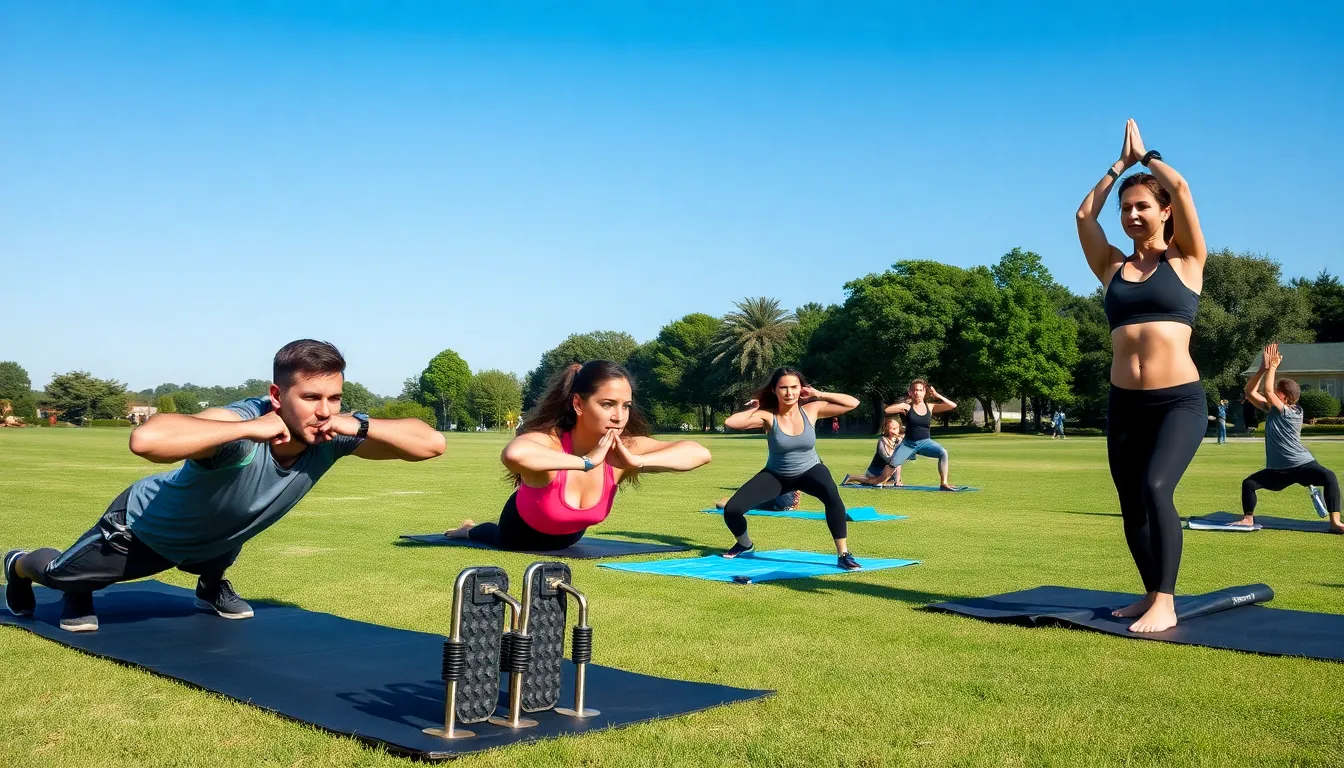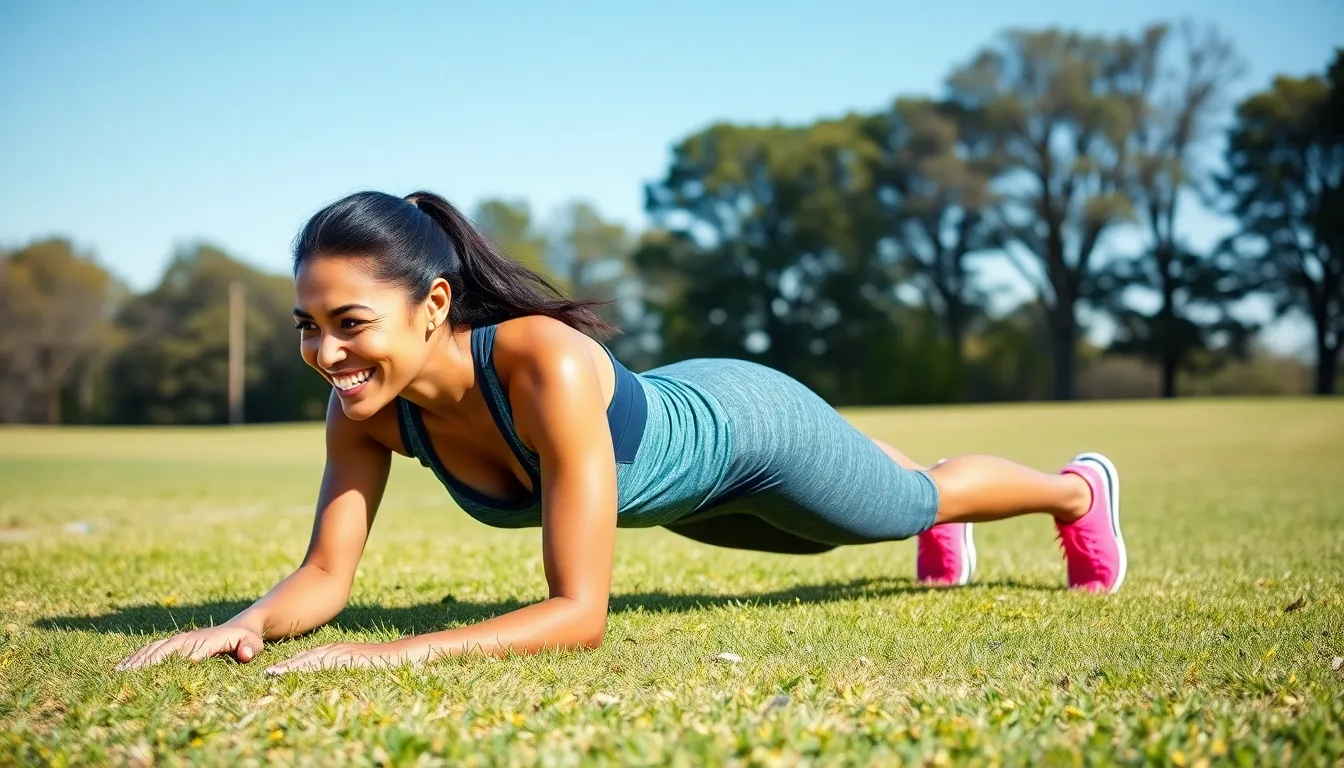In a world where fitness often seems tied to expensive gym memberships and fancy equipment, no equipment workouts are a game changer. They offer a flexible and accessible way for anyone to stay fit, regardless of their location or budget. Whether at home, in a park, or even at the office, these workouts can be done anywhere, anytime.
No equipment workouts focus on bodyweight exercises that build strength, endurance, and flexibility. They empower individuals to take control of their fitness journey without the intimidation of a gym environment. With creativity and determination, anyone can sculpt their body and boost their health using just their own weight. Embracing these workouts not only saves time and money but also opens the door to a more sustainable and enjoyable fitness routine.
Table of Contents
ToggleBenefits Of No Equipment Workouts
No equipment workouts offer numerous benefits, making them an appealing choice for many individuals. These workouts enhance accessibility and convenience, while also promoting financial savings.
Convenience And Accessibility
Convenience characterizes no equipment workouts. Individuals can perform exercises at home, outdoors, or while traveling, eliminating dependency on gym schedules or locations. Accessibility simplifies fitness for everyone, regardless of fitness level or experience. Bodyweight exercises, such as push-ups and squats, require minimal space and can adapt to various fitness capabilities. No equipment workouts enable individuals to integrate fitness seamlessly into their daily routine, encouraging consistent engagement.
Cost-Effectiveness
Cost-effectiveness remains a significant advantage of no equipment workouts. These workouts eliminate expenses associated with gym memberships or purchasing exercise equipment. Individuals can access comprehensive fitness routines without financial burden, allowing them to focus solely on their health goals. By choosing bodyweight exercises, individuals maintain fitness without compromising results, proving that effective workouts don’t require high costs.
Types Of No Equipment Workouts

No equipment workouts encompass various exercise types, making them versatile for any fitness level. The following categories highlight popular methods for achieving effective workouts without gear.
Bodyweight Exercises
Bodyweight exercises utilize the individual’s weight for resistance, targeting multiple muscle groups. Common exercises include:
- Push-ups: Strengthen the chest, shoulders, and triceps.
- Squats: Engage the lower body, including quadriceps, hamstrings, and glutes.
- Lunges: Work on leg strength and improve balance.
- Planks: Build core stability and overall body strength.
- Burpees: Combine strength and cardio for a full-body workout.
These exercises can be modified for different skill levels, ensuring accessibility for beginners and seasoned athletes alike.
High-Intensity Interval Training (HIIT)
High-Intensity Interval Training (HIIT) maximizes calorie burn and improves cardiovascular fitness. This training method alternates short bursts of intense activity with rest periods. Key HIIT exercises include:
- Jumping jacks: Elevate heart rate quickly.
- Mountain climbers: Target core and lower body while increasing intensity.
- High knees: Boost cardiovascular endurance and leg strength.
- Tuck jumps: Enhance explosiveness and coordination.
- Shadow boxing: Increase agility and burn calories.
HIIT workouts can be customized for duration and intensity, appealing to various fitness enthusiasts.
Yoga And Flexibility Routines
Yoga and flexibility routines focus on enhancing mobility and promoting relaxation. These sessions improve balance and flexibility while reducing stress. Notable poses include:
- Downward Dog: Stretches the hamstrings and calves while strengthening the arms.
- Warrior Pose: Builds strength and stability in the legs and core.
- Seated Forward Bend: Increases flexibility in the spine and hamstrings.
- Child’s Pose: Provides a restorative stretch for the back and hips.
- Bridge Pose: Strengthens the glutes and opens the chest.
Incorporating yoga into a fitness routine can enhance recovery and mental well-being while building physical strength.
How To Create A No Equipment Workout Plan
Creating a no equipment workout plan involves setting clear goals and selecting appropriate exercises. This approach ensures a structured routine that accommodates individual fitness levels and objectives.
Setting Goals
Establishing goals serves as the foundation for a successful workout plan. Specific goals can include improving endurance, increasing strength, or enhancing flexibility. Measurable milestones, such as completing a certain number of reps or holding a pose for a designated time, provide clear benchmarks for progress. Attainable goals foster motivation and commitment. Relevant goals, aligned with individual needs and abilities, help maintain focus. Time-bound objectives, such as achieving a goal within weeks or months, encourage accountability and consistency.
Choosing Exercises
Selecting exercises requires consideration of fitness levels and personal preferences. Effective exercise categories include:
- Strength Exercises: Push-ups and squats utilize body weight to build muscle and endurance.
- Cardio Exercises: High knees and jumping jacks increase heart rate and improve cardiovascular health.
- Flexibility Exercises: Yoga poses like Downward Dog and Cobra enhance mobility and promote relaxation.
- Core Exercises: Planks and mountain climbers strengthen abdominal muscles and improve stability.
Mixing various exercises within each category creates a balanced routine that addresses different fitness aspects. A well-rounded no equipment workout plan should incorporate multiple exercises ensuring engagement and preventing monotony.
Tips For Maximizing Your No Equipment Workouts
Maximizing no equipment workouts involves focusing on techniques that enhance efficiency and effectiveness. Implementing good form and increasing workout intensity can lead to better results.
Maintaining Proper Form
Maintaining proper form is crucial for preventing injuries and ensuring workouts are effective. Prioritize alignment and body mechanics during each exercise.
- Focus on Core Engagement: Activate core muscles to stabilize the body during exercises like planks and squats.
- Control Movement Pace: Perform exercises steadily to maintain form and focus on muscle engagement.
- Adjust Exercise Modifications: Use variations, such as knee push-ups for beginners, to adapt exercises while preserving form.
Increasing Intensity
Increasing workout intensity can boost calorie burn and improve fitness levels. Implement strategies to elevate effort during no equipment workouts.
- Incorporate Short Intervals: Use interval training techniques, alternating between high-intensity bursts and brief rest periods.
- Add Plyometric Movements: Integrate exercises like jump squats or tuck jumps to elevate heart rate and challenge strength.
- Utilize Time Under Tension: Extend the duration of each movement, slowing down the eccentric (lowering) phase for increased muscle engagement.
These tips enhance the quality and impact of no equipment workouts, promoting efficient progress toward fitness goals.
No equipment workouts offer a practical solution for anyone looking to stay fit without the barriers of gym memberships or expensive gear. Their flexibility allows individuals to exercise anytime and anywhere, fostering a more consistent fitness routine. By focusing on bodyweight exercises and incorporating various workout styles, these routines cater to all fitness levels.
With the right planning and commitment, anyone can create an effective no equipment workout plan that aligns with their personal goals. Embracing this approach not only saves money but also empowers individuals to take charge of their fitness journey. Ultimately, no equipment workouts are a viable path to achieving health and wellness.


